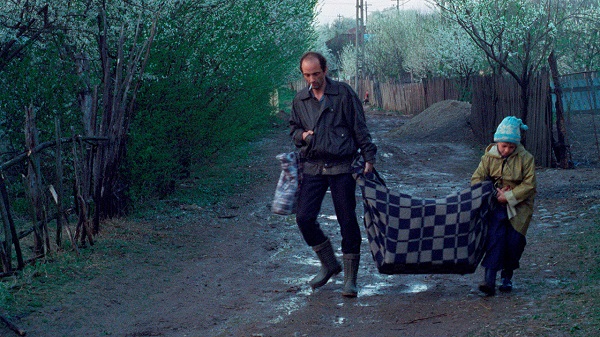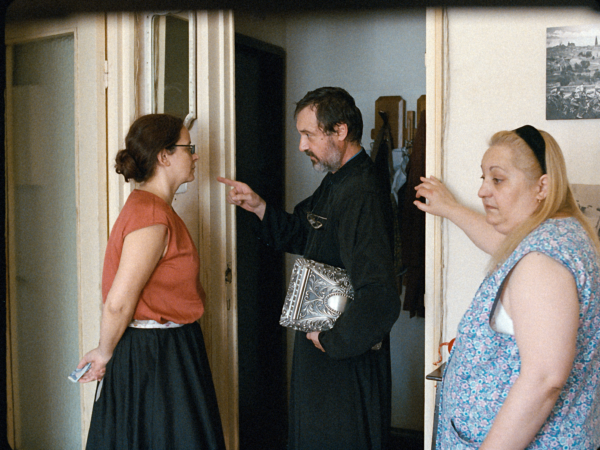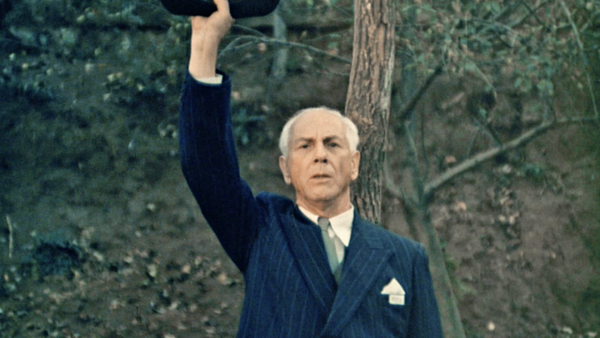Inside the Small Research Department
Radu Jude’s Short Films
The short film format is where prolific Romanian filmmaker Radu Jude feels most free. From political satires to oddball video essays, his shorts often mix philosophical analysis with playful experimentation.

Hot off the heels of his latest opus, Do Not Expect Too Much from the End of the World, FeKK Ljubljana 2024 hosted an in-depth retrospective programme dedicated to Radu Jude’s short films. Presented alongside each other, these nine works curated by Peter Cerovšek offer fascinating insights into how the prolific Romanian filmmaker has developed his generous cinematic sensibilities.
With some forms of experimental cinema (and conceptual art in general), there is the risk of works becoming hermetically sealed. As if specific instructions are sometimes required to correctly engage with the piece of art, lest you become lost within its maybe too demanding structure. So, when a curious director like Radu Jude comes along—someone who makes essayistic films that feel fresh, fun, open, and invigorating—it somehow re-energises how you can think and talk about cinema. And thinking through cinema is exactly what the Romanian director is all about. From his humble early short films like The Tube With a Hat (2006) to his more recent opus Plastic Semiotic (2021), Jude has proven himself time and time again to be a chameleonic figure of contemporary film, often reflecting on Romania’s deeply buried historical traumas and present-day pains by making grand fiction features, scorching political satires, rigorous archival documentaries, eccentric formal experiments, and oddball video essays.
This anything-goes approach has been part of Jude’s modus operandi for a while now when it comes to his acclaimed features. A meticulous Romanian western in black-and-white like Aferim! (2015) can stand shoulder to shoulder with the Brechtian political critiques of Uppercase Print (2020). The somber archival approach of The Dead Nation (2017) and The Exit of the Trains (2020) justify their place in his oeuvre just as much as seemingly more frivolous fare like recent Locarno-titles Eight Postcards from Utopia and Sleep #2. Following this trend, his eclectic yet reliably strong mix of short films constantly find ways to compliment his feature works, only revealing how his approach to making film, often with repurposed archival material, has gradually become more eccentric, more open, more free, and especially more generous.
It’s exactly in the transparency of his process, and the way the films revel in showing the seams of the material used, that his work—no matter how experimental—becomes so inviting to engage with. Jumping into Jude’s oeuvre is like partaking in a philosophical debate on cinema itself, although one that’s way less daunting than you might make it out to be. See it rather as one of those post-film discussions with friends in a bar, diving into a lively chat with a beer in hand. It’s just that, in this case, the discussion cuts a bit deeper and extends much further into the ontological nature of the medium film. Exchanging ideas over email about his wildly prolific cinematic output proved exactly this: how enjoyable it is to discuss cinema with Radu Jude and how he uses every occasion to playfully and skillfully ruminate on this artform. It’s an exchange that once again confirms how rigorous philosophical analysis and playful experimentation go hand in hand within Jude’s many films, both short and long.
Plastic Semiotic is the short film I’ve rewatched most in my life, partially because it’s a great film to show others, to give them a sense of how you can play around with montage and this thing we call “experimental cinema”. The film literally captures the sensation of play—with dolls, toys, intellectual references, and principles of montage. What was that process like for you?
I’ve half-jokingly said that it was [me taking] revenge against my kids for hitting my feet against their toys for so many years. The difference in age between them is ten years, so I have the feeling I have been around toys all my adult life. Maybe because of that, I started paying more attention to them, and, like in everything, if you pay attention, you discover that things are more complex and interesting than they seemed at first.
This grew into the desire to organise the toys I have found (the oldest ones coming from a collector who wants to make a kind of Toys Museum) so that it can become a film. This process was a bit more complicated, and I was also confused—this confusion can be seen in the film. I don’t have a problem with it right now; perhaps the film is even better this way, but if you analyse it closely, you will notice different strategies that don’t go together so well. There is a certain narrative direction alongside an analytical one, and sometimes they clash. I re-edited the film a few times, and I think, in the end, the film works only if the viewers do half of the work for themselves. I hope that’s pleasant work, though.
In general, your short films of late have been gravitating much more around montage as an organising principle, especially if you compare them with your more narrative-focussed shorts like The Tube With a Hat, Alexandra, and Shadow of a Cloud. Can you trace—via your shorts—where these cinematic developments come from?
Forcing myself to find an answer, I see that things come from a necessity of some kind. When I made my first film, Aferim!, which deals with history, I felt like hitting a wall, and I needed to find ways to solve all the problems that arose, especially the ones dealing with representation. It also stems from the desire to experiment, maybe because I am not talented. I don’t have a [particular] style or a vision, so I always need to work and search for directions or solutions. And, of course, as I always needed to enter a dialogue with works of authors that influenced me, there is this desire to find a way to offer an answer to those works. For instance, in Caricaturana or The Potemkinists, I wanted to engage in a dialogue with Eisenstein despite my limited capabilities.
You notice correctly that it is a gravitation towards montage, but maybe also a gravitation towards essay, but in a broader way, as Rivette considered it. Allow me to quote from him: “[C]inema is, fundamentally, a descriptive and didactic art: the two are linked. It is only an accident of history that storytelling has become almost consubstantial with it. Its true vocation is the essay: that is to say, the descriptive ordering of reality, the revelation of the relations, links, and concordances of the various phenomena. All in all, it is an art of concordance of times—and spaces. All the great films tend to be pure gaze, but a lucid gaze that orders confusion by its sole intrusion, by the sole fact of settling on things: Tabu by Murnau, The River by Jean Renoir, Voyage en Italie, Red River, Rear Window, so many films where the direction intervenes only to order a cosmos and, through description, to encircle it with the most skilful logic; so many films where contemplation finds secrets lost in the heat of the action. We must, following Goethe’s advice, begin—and end—with the art of description, learn to show all things, even the most humble, “as never before seen”.”
Your early short films often revolve around things breaking. The broken television of The Tube With a Hat sets off this arduous journey of father and son, which is mirrored by the frustrated dad in Alexandra, who had broken a television himself with an axe. Things are simply not working in many of your films, which could be a metonymy of our broken neoliberal society. Where does this fascination come from?
I think that cinema looks at things or realities that don’t work, and this should be true in any society (neoliberal or not). So, in this light, broken objects should be expected to enter the films. As do broken people, if I can say so.
Can you talk about your collaboration with cinematographer Marius Panduru, with whom you have shot many of your films, many also in completely different styles? How do your shifting sensibilities match now you make films that look and feel completely different?
Marius Panduru is brilliant. He has immense technical knowledge, a great sensibility, and a lot of humour. I remember he was not eager to experiment many years ago, but now he is very free and open to everything. I learn a lot from him. And something else: he is extremely fast, one of the fastest[-working] cinematographers I have ever met. This is essential for someone like me, who never had enough budget for many shooting days.
The FeKK-retrospective featured Punish and Discipline and The Marshal’s Two Executions, two films that deal with archival material in different ways. Forgive the broad question, but what does the archive mean to you in relation to cinema?
At the beginning, of course, some materials don’t belong to me as the maker of the film. But the beautiful thing is that, after a while, you don’t make that distinction anymore. When editing, it doesn’t matter who shot the images. Language plays a trick here because you might say, “I made this image”, but actually, it is a camera that did. It is, of course, true that you decided on the framing and many other things, but in the end, the image is a machine creation. Nowadays, you can add an AI generator to this toolkit. I am not saying it is the same thing (a montage film and a staged one); I am just saying that, after a while, it feels like it is the same thing.
If you take the alphabet montage of Bad Luck Banging or Loony Porn or the sequence of roadside crosses in Do Not Expect Too Much from the End of the World, you already see this eagerness to break through the conventional formatting and structuring of a narrative feature film. How do you see these sequences—which could be presented as standalone works quite easily—in relation to your short film work?
I am not sure that those scenes could stand alone. Even if they do, for me, it is important that they are part of the feature film. They find their true meaning only in that context. Of course, you can take them out and put them in other contexts, and they find new meanings. I always do that with other images.
Regarding the short film format: As a Zen poem says, “Flowering branches grow naturally. Some short, some long”, and this is true with films also. Then, we must remember that Rossellini always complained that the cinema industry doesn’t have a research department, as all successful industries have (cars, computers, etc). I consider my short films a small research department for myself: it is less pressure, less money, and you are more free to experiment.
Mentioned Films

The Tube With a Hat
by Radu Jude, Romania, 2006, 23’
Very early in the morning, Marian, a 7-year-old boy from a small Romanian village, wakes up his father and persuades him to go to the city to fix their old TV set. The father and son begin carrying the TV set there, hoping they will find Bichescu, a specialist, who will fix their problem.

Plastic Semiotic
by Radu Jude, Romania, 2021, 22’
The average life of human beings—from birth to old age—is represented by children’s toys. Barbie dolls, plastic dinosaurs, and model cars are assembled to recreate life’s inevitabilities, including holidays, traffic jams, and death.

Alexandra
by Radu Jude, Romania, 2006, 24’
Tavi, a forty-year-old divorced father, comes to his ex-wife’s home to repair his four-year-old daughter’s bike, Alexandra. He realises with amazement that Alexandra does not call him Daddy anymore.

Shadow of a Cloud
by Radu Jude, Romania, 2013, 30’
On a baking hot day in Bucharest, priest Florin Florescu arrives at a quiet home to administer the last rites to a dying woman. But not everyone is happy with the visitor and his Christian ritual.

Caricaturana
by Radu Jude, Romania, 2021, 9’
Inspired by an idea from Soviet director Sergei Eisenstein, director Radu Jude silently flips through satirical lithographs by 19th-century French artist Honoré-Victorin Daumier. Soon, the caricatures’ original texts are read out. Finally, the caricatures are used as commentary for actual news.

The Potemkinists
by Radu Jude, Romania, 2022, 18’
In 1905, the rebellious sailors on the battleship Potemkin are given political asylum in Romania—an act of defiance against Russia. In 2021, as a sculptor plans an artwork inspired by the event, he unveils the truth behind the fictional elements of Sergei Eisenstein’s Battleship Potemkin.

Punish and Discipline
by Radu Jude, Romania, 2019, 12’
A montage film about state power and its violence, composed by the juxtaposition of two sets of materials: a text from the 19th century and a collection of photographs from the Communist dictatorship.

The Marshal’s Two Executions
by Radu Jude, Romania, 2018, 10’
Two different views of the execution of Romanian wartime dictator Ion Antonescu confront one another. On one side is silent footage recorded in 1946 by cameraman Ovidiu Gologan, and on the other side are scenes from a biographical film shot five decades later by director Sergiu Nicolaescu.
